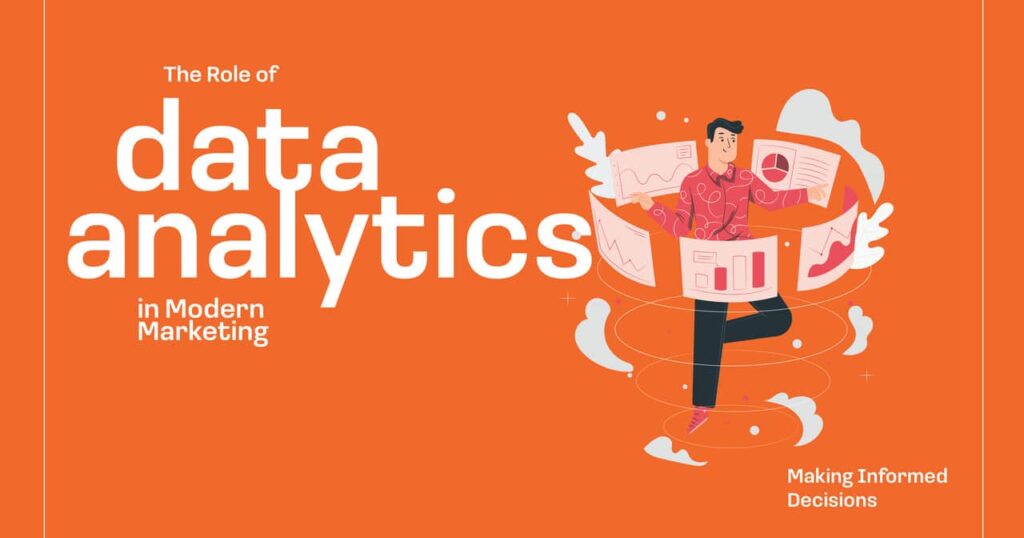Data analytics has become a cornerstone of successful marketing strategies in today’s fast-paced digital world. Gone are the days when marketers relied solely on gut feelings or blanket approaches.
Essential Takeaways:
- Data is Key: Data analytics provides critical insights into customer behavior, helping you craft targeted and effective marketing strategies.
- Optimize Campaigns: Continuous tracking and analysis of key metrics allow for optimizing campaigns in real time for better results.
- Predictive Analytics Drive Growth: Marketers can anticipate trends and customer needs using predictive analytics, enabling proactive decision-making.
Now, with vast amounts of data, businesses can make more informed decisions, optimize their campaigns in real time, and understand their customers like never before. This blog post dives deep into the role of data analytics in modern marketing and how it helps businesses drive better results.
Introduction to Data Analytics in Marketing
Marketing has always been about understanding your audience and delivering the right message at the right time. But how do you know what your audience wants? Enter data analytics. It allows marketers to analyze vast amounts of data to identify trends, understand customer behavior, and ultimately, create more targeted and effective campaigns. The wide range of data available today enables businesses to employ statistical methods to derive actionable insights.
What is Data Analytics in Marketing?
Data analytics is the process of collecting, analyzing, and interpreting data to make informed decisions. In marketing, it means using data from various channels—social media, website traffic, email campaigns, and more—to gain insights into customer behavior, preferences, and purchasing patterns. This process includes various analysis techniques such as descriptive analytics, diagnostic analytics, predictive analytics, and prescriptive analytics.
Data-driven marketing relies on real-time insights to optimize campaigns, personalize experiences, and allocate budgets more effectively. It’s about understanding what works and what doesn’t, making adjustments based on actual data rather than assumptions. Business analysts play a crucial role in this, utilizing advanced analytics technologies to transform complex datasets into meaningful insights.
The Shift from Traditional to Data-Driven Marketing
In the past, marketing was a guessing game. Companies would create campaigns based on intuition, historical performance, or industry trends, often lacking the sophisticated analytics methods that drive effective business decision-making today. But things have changed.
With data analytics, marketers can pinpoint exactly where their efforts are paying off. They can track which campaigns perform well, which audiences engage, and which platforms deliver the best results. This shift from traditional to data-driven marketing has revolutionized the way businesses operate, providing valuable insights that inform business strategy.
Benefits of Data-Driven Marketing:
- Precision: Data analytics enables highly targeted campaigns. Instead of casting a wide net, businesses can tailor messages to specific customer segments using customer segmentation techniques.
- Cost Efficiency: With data, you can optimize budgets by focusing resources on campaigns that yield the highest returns, driving cost savings through informed decisions.
- Real-Time Adjustments: Marketing strategies are no longer set in stone. Data allows for real-time optimization, ensuring that campaigns always perform at their best.
How Data Analytics Enhances Marketing Efforts
Data analytics improves and transforms marketing. By leveraging data, businesses can build more personalized, relevant, and efficient marketing strategies that resonate with their audience.
Understanding Customer Behavior
One of the most valuable aspects of data analytics is the ability to analyze customer behavior in depth. Marketers can track everything from the pages visitors view on a website to how long they stay on each page and which products they add to their cart.
This insight helps businesses understand what customers are doing and why they’re doing it. By knowing the “why,” marketers can create campaigns that align with customer needs and preferences, increasing the likelihood of conversion. Exploratory data analysis reveals hidden insights that can drive campaign strategies.
For example, an e-commerce site might notice that customers who view a specific product page are likelier to abandon their carts. With this information, the company can create retargeting campaigns or offer personalized discounts to encourage customers to complete their purchases, significantly enhancing customer retention.
Personalization and Customer Segmentation
Today’s consumers expect personalization. They want to feel that businesses understand their unique needs and preferences, and data analytics makes this possible.
Through customer segmentation, marketers can group their audience into smaller segments based on shared characteristics—such as demographics, purchase history, or online behavior. These segments allow marketers to deliver tailored content that directly addresses customers’ interests.
For example, instead of sending a generic email blast to all subscribers, a retailer could use segmentation to send personalized product recommendations based on a customer’s previous purchases. This strategic use of analytics solutions increases engagement rates and customer satisfaction.
Optimizing Marketing Campaigns
Data analytics gives marketers the tools to monitor and optimize campaigns in real time. Whether it’s adjusting a social media ad that isn’t performing well or tweaking the subject line of an email to improve open rates, data allows marketers to make informed decisions that will enhance campaign performance.
A/B Testing is one of the most popular methods for campaign optimization. By running two versions of a campaign—such as two different ad headlines—marketers can use data to determine which version resonates better with their audience.
Additionally, data analytics helps businesses save money on underperforming channels. By tracking key metrics like cost-per-click (CPC), cost-per-acquisition (CPA), and return on investment (ROI), companies can allocate budgets more effectively, focusing on the channels that provide the best results.
Predictive Analytics in Marketing
Predictive analytics takes data further by using historical data and algorithms to forecast future outcomes. In marketing, predictive analytics is used to anticipate customer behaviors, preferences, and buying patterns.
For instance, a subscription-based company might use predictive analytics to determine which customers will likely churn. With this knowledge, they can create personalized retention campaigns to keep those customers engaged. This forward-thinking approach is essential for business leaders aiming to stay ahead of market trends.
Predictive analytics also helps marketers identify upsell and cross-sell opportunities and predict which products or services customers are likely to be interested in next, thus enhancing customer experiences.
Key Data Analytics Tools for Modern Marketers
There’s no shortage of tools to help marketers gather, analyze, and interpret data. Here are a few of the most popular ones:
- Google Analytics: One of the most powerful tools for understanding website traffic. It provides a wealth of data on user behavior, including how visitors find your site, which pages they spend the most time on, and where they drop off.
With Google Analytics, marketers can measure the success of their campaigns, track conversions, and gain insights into customer behavior. It’s an essential tool for any business looking to optimize its digital presence using analytics platforms.
- CRM Systems: Customer relationship management (CRM) systems like Salesforce and HubSpot are invaluable for managing customer data. These platforms allow businesses to store and analyze customer interactions across multiple touchpoints—from sales to customer service.
CRM data helps marketers understand the entire customer journey, making it easier to deliver personalized experiences and nurture leads through the sales funnel, ultimately enhancing business outcomes.
- Social Media Analytics: Platforms like Facebook, Instagram, and LinkedIn provide built-in analytics tools that allow marketers to track engagement metrics like likes, shares, comments, and clicks. By understanding how users interact with content, businesses can adjust their social media strategies to engage their audience better.
Third-party tools like Hootsuite and Sprout Social offer more advanced analytics, allowing marketers to track metrics across multiple platforms and better understand social media performance.
Challenges of Implementing Data-Driven Marketing
While data analytics offers many benefits, implementing it into your marketing strategy isn’t without its challenges.
Data Privacy and Security
With the increasing focus on data privacy, businesses must ensure they’re handling customer data responsibly. Regulations like the GDPR (General Data Protection Regulation) and CCPA (California Consumer Privacy Act) have strict guidelines on how companies can collect, store, and use customer data.
Marketers need to comply with these regulations while still leveraging data to improve their campaigns. Transparency is key—customers should know how their data is being used, and businesses should provide clear opt-out options.
Data Overload
In the digital age, businesses can access more data than ever. While this is generally a good thing, it can also be overwhelming. Sifting through large volumes of data to find actionable insights can be a time-consuming and daunting task.
To combat data overload, marketers should focus on the metrics that matter most to their business goals. Tools like dashboards and automated reports can help streamline the data analysis process, ensuring marketers spend less time sifting through data and more time acting on insights.
Bridging the Skills Gap
Another challenge is that not all marketing teams have the skills to implement data-driven strategies effectively. Data analytics often requires knowledge of specialized statistical analysis, machine learning, and data visualization.
Businesses can address this gap by investing in training programs to upskill their marketing teams or hiring dedicated data analysts to manage and interpret data. Online learning platforms can provide degree programs and certification options that equip professionals with essential analytics skills.
The Future of Data Analytics in Marketing
Data analytics continues to evolve, and the future looks even more promising with the rise of artificial intelligence (AI) and machine learning. These technologies allow marketers to analyze vast datasets more quickly and accurately, leading to deeper insights and more effective campaigns.
AI and Machine Learning in Data Analytics
AI and machine learning are already used in tools like chatbots, recommendation engines, and programmatic advertising. As these technologies advance, they’ll play an even bigger role in marketing, allowing businesses to predict customer behavior more accurately and automate decision-making processes.
The integration of natural language processing (NLP) will also enable marketers to gain insights from unstructured data—like customer reviews and social media comments—providing a broader understanding of customer sentiment.
Conclusion
Data analytics has fundamentally changed the marketing landscape, enabling businesses to make informed decisions, optimize campaigns, and understand their customers like never before. By leveraging data effectively, businesses can drive better results and stay ahead of the competition.
As technology continues to advance, those who embrace data-driven marketing strategies will be well-positioned for success in an increasingly competitive landscape.
FAQs:
- What is data analytics in marketing?
Data analytics in marketing involves using data to measure and improve campaign performance, audience targeting, and overall strategy.
- How does data improve marketing strategies?
It helps understand customer preferences, optimize engagement, and measure ROI, leading to more informed decisions.
- What tools are commonly used for marketing analytics?
Popular tools include Google Analytics, HubSpot, and Tableau, which help track campaign performance and audience behavior.
- How can small businesses use data analytics?
Small businesses can leverage data to refine targeting, improve conversion rates, and allocate marketing budgets effectively.
- What is the role of predictive analytics in marketing?
Predictive analytics forecasts customer behavior and market trends, helping businesses stay ahead of the curve









